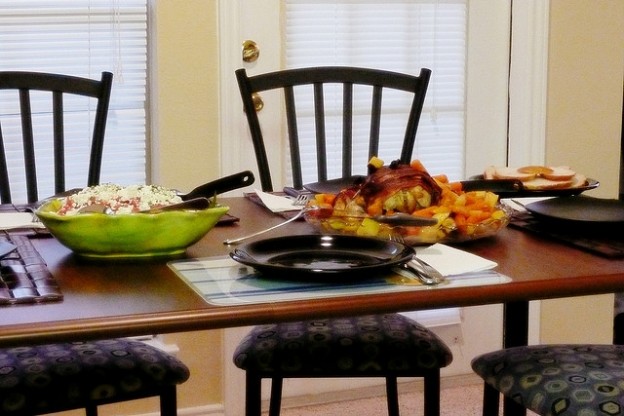
Photo: ecooper99/Flickr
Anne Fishel is an Associate Clinical Professor of Psychology at the Harvard Medical School and Director of Family and Couples Therapy at Massachusetts General Hospital. Most recently, she helped launch The Family Dinner Project, a collaborative, team-led organization committed to helping families and communities make mealtime more meaningful, and therefore more healthful on many levels.
Talking about family dinners is a focus of Anne’s work with the families she treats in her private practice and with the psychiatry residents she trains to work with families. Below, she discusses the physical space and settings of family dinners, and the collective impact on social dynamics and conversation.
What happens in your family?
Anne K. Fishel, Ph.D.
The Family Dinner Project
As a family therapist I am interested in context—why is a child seen as bossy at home but not at school? What allows a couple to have a lively conversation in a restaurant on Saturday night, but not in their own kitchen?
In my work with The Family Dinner Project, I encourage families to have more dinners with one another, and part of my strategy is to look for the elements of dinner that are playful and easy to change. Context is a prime one. If you change the seating or set the table with care, maybe even with flowers and candles, a new mood is created, and a new conversation may develop. This is also why, as a family therapist, I encourage my clients to sit in different seats in my office: perspectives can change when you see the world from a different vantage point.
At home, my young adult sons would much rather crowd around our too-small kitchen table for dinner than let their 6-foot-plus frames sprawl and spill around our more spacious dining room table. It’s not just the smaller size that feels cozier, but eating in the kitchen feels homier than eating in the dining room, which is where guests eat, not sons reclaiming their places at the regular family table. What’s more, my sons always tuck into their customary seats around the table — no matter how long they’ve been away.
When I talk to other families, most tell me the same thing: each family member sits in the same chair night after night. No one can quite remember how these decisions were made. But, in most families, it is considered a subversive act to claim a seat that isn’t yours. In my husband’s family, the girls sat on one side of the table, nearer the stove, so that they could spring up to get more food, while the boys sat on the far side. As with most rectangular tables, the parents sat at either end, connoting higher status as heads of the table.
But sitting on chairs around a table isn’t a universal custom. In many societies, chairs and tables are seen as stiff and formal, useful mainly for conveying status. Often they are reserved just for solemn occasions. The only position that connotes higher status than sitting is lying down — thus the extreme luxury of being served breakfast in bed.
Many people sit on the floor to dine, with trays of food. Another common custom in other cultures is for each diner to have his or her own table. The formal Japanese diner, for example, has a small lacquered table all to himself, or he might even have two or three of them. Greeks in the Classical period each had a small oblong three-legged table. Food might be set directly on the tabletop. A new course was called second or third tables, with each new course arriving on a separate table that was light and portable.
Many American families eat dinner around a kitchen island. My friend Wendy, a mother of four kids, compared the quality of conversation that her family has when dining at the island rather than at a table:
When kids sit at an island, they expect to be served, and I feel more like a waitress (because I’m standing on the other side and not eating at the same time) with very little discussion. But when we all sit down together, it’s more of a collaborative experience — we all eat and talk together.
Family dinners can be jazzed up by introducing a new recipe or by having a guest come to dinner. But family dinner conversation will be affected by paying attention to space.
Here’s what you might do shake up the “where” of family dinners. Try spreading a blanket on the floor and eating dinner without chairs, in a different room, or outside. What happens when no one sits in customary seats? Is there a round table to sit around instead of a rectangular one? What if you sit very close or with more distance between seats? What spatial ingredients lead to the best conversations in your family?
Previous posts featuring Anne Fishel:
Ethics, Civil Discourse and the Family Meal
Roll Reversal: Dinner with a Young Adult Son
Family Dinners

Pingback: Meeting Your Child’s Sweetheart: 12 Tips For A Successful Meal | Public Radio Kitchen